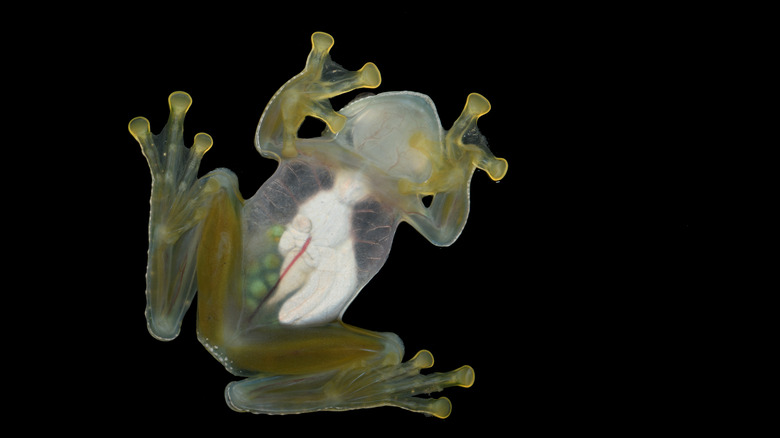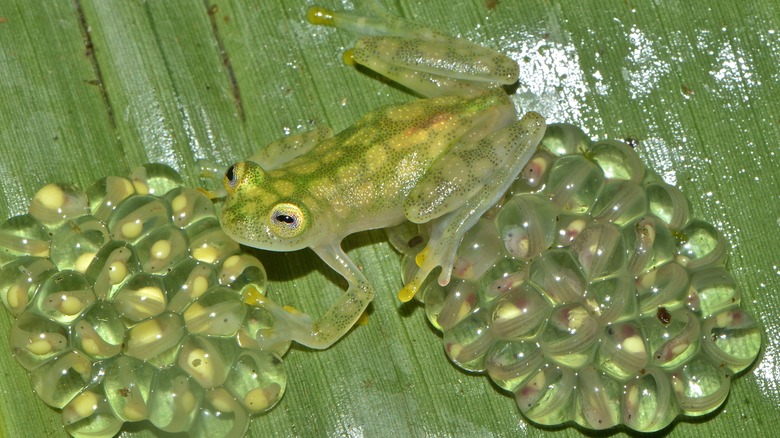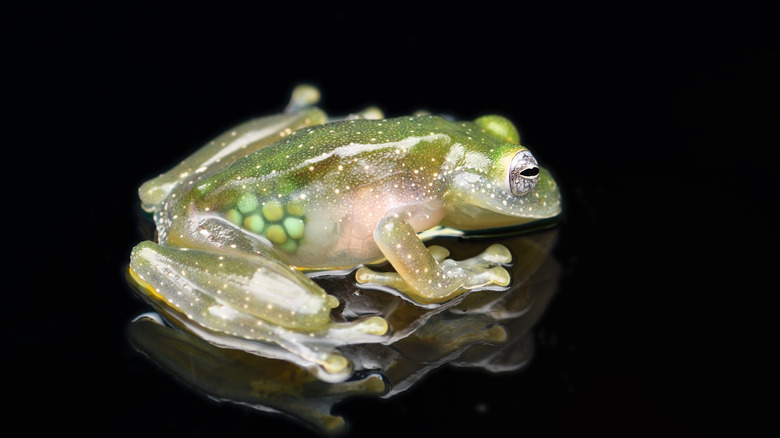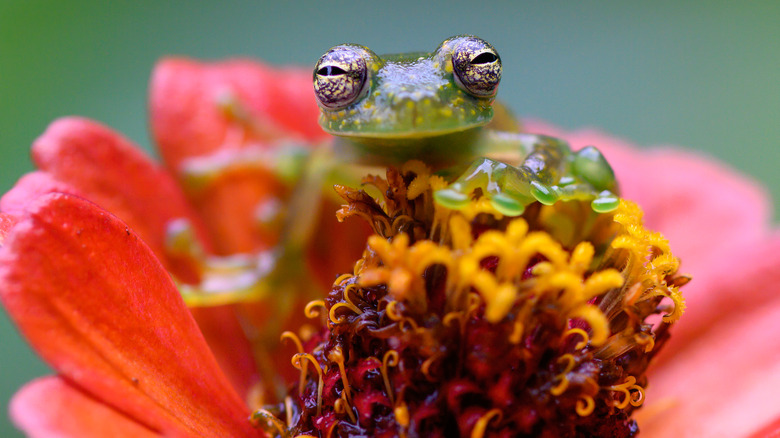The Mystery Behind Two Newly Discovered See-Through Frogs
Planet Earth produces some of the most mystifying creatures. If you spend enough time exploring, you'll find star-nosed moles, glow-in-the-dark sharks, wingless wasps that look like pandas, and of course, see-through frogs.
Frogs adorned in transparent ventral skin have a rather unique physical attribution — you can look right through their flesh to see their organs (via PNAS). These translucent creatures are known in the scientific community as glass frogs. Their skin, which craftily displays their insides like transparent glass, is a kind of high-fidelity camouflage meant to disguise them from predators. The fact that the skin exposes their tiny red beating hearts is really just an interesting consequence of that disguise.
Looks can be deceiving, especially in creatures that are crystal clear. Take, for example, science's latest discovery: two new glass frog species whose camouflage is beyond skin deep. The real mystery here is not the Frankenstein-esque display of reptilian organs exposed in full view like a high school science class dissection. Freakier still is what scientists found in their DNA (via National Geographic).
International researchers discovered two new glass frogs in the Ecuadorian Andes
According to National Geographic, there are 156 known species of glass frogs hopping around the planet. This is a clear fact. In March of 2022, scientists added the two newest names to that list, and with them, a new mystery unfolds. The newly discovered Mashpi glass frog (Hyalinobatrachium mashpi) and the Nouns' glass frog (Hyalinobatrachium nouns) are baffling scientists, and not for the reason you might expect.
When a team of international researchers first discovered these odd-looking amphibians in the Andes region of Ecuador, they immediately recognized them as glass frogs. Their telltale see-through bellies were undeniable clues. The scientists also noted that their dorsal coloration and transparent pericardium differed in appearance from other glass frogs, making them a new species (per Sci-News). What scientists failed to realize at first was that these were two different species of glass frogs that looked exactly the same.
DNA tests shockingly revealed they were two separate species
National Geographic reports that Juan Manuel Guayasamin, an evolutionary biologist and the author of the PeerJ article detailing this event, made the following statement regarding the odd amphibians: "At first, we started to collect them, we thought they were the same species."
And on the surface, they absolutely were. The frogs were roughly the same size, with piercing lime greenbacks and clear bellies. Bulging yellow eyeballs wrap around their unmistakable smiles, and their see-through skin is spotted with microscopic black dots, making the frogs look a bit like pepper spilling into a bowl of Jello. They were even found within 13 miles of one another and were spotted hanging out in similar altitudes, temperatures, and atmospheric conditions.
It wasn't until DNA tests were conducted that scientists discovered the frogs possessed diverse DNA and were actually two different species. Their genetic divergence awes at 4.6- 4.7%, a gap that is uncommon for species that look this similar on the surface. Experts suspect that the valley at the edge of the Guayllabamba River served as a geographic barrier, separating a frog species that might have initially been the same but over time developed an accumulation of genetic mutations that made them quite different under the microscope.
These two unique frogs exemplify cryptic diversity
According to ScienceDirect, the phenomenon that occurs when two creatures look morphologically identical but possess genetic diversity in their DNA is known as cryptic diversity. For three full centuries, cryptic diversity has baffled scientists, causing them to classify some species incorrectly. Thanks in large part to advancements in rapid DNA sequencing, cryptic diversity is much less of an obstacle and much more of a spectacle to marvel over.
The prevalence of cryptic diversity paints a portrait of a much more biologically diverse planet than we ever suspected in the past (via The Guardian). How exciting to learn there might be brand new species hiding in the subsects of species we have already identified. As a testament to this statement, scientists have spotted new species within the African elephant, Indian vine snake, and neotropical bird populations using a new DNA barcoding technique. It appears that even the world we thought we had fully explored is rife for reexploration and likely brimming with genetic surprises. As a result, some experts now believe that the number of potential species on Earth is much higher than the previous estimate of 8.7 million.
Two different species, two different worlds
Imagine twins separated at birth and raised within just a few miles of each other, but one lives in a rural farm town while the other resides in a bustling city. Their whole lives, they are separated by a bridge at the border where the city sidewalks end. This is essentially the existence of these two frogs. Their DNA tells the tale of a divided, little-known region and, on a larger scale, the hidden diversity that exists there. According to PeerJ, it is not at all uncommon to find "sister species" in the Toisán mountain range, particularly between the Mira river valley and the Intag-Guayllabamba river valley.
The north-residing frog and the south-residing frog never meet but share a wealth of similar characteristics that are immediately recognizable to observers. According to National Geographic, both enjoy swaying from the undersides of leaves guarding transparent eggs with their encapsulated offspring inside. The H. mashpi frog even makes a sound similar to a different frog that is scientifically referred to as H. valerioi. Both of these frogs' vocals are reminiscent not just of another species but of an entirely different creature — namely, the cricket.
Sadly, both species are already endangered
In a tragic story of the Andes region, it appears that neither the south side nor the north side is safe from deforestation and habitat loss (via PeerJ). Scientists identify amphibians as the most threatened vertebrates in the Andes Mountains, where the dark side of human industrialization takes its toll on freshwater and terrestrial ecosystems at every river's bend (per ScienceDirect).
To that end, both of these fascinating creatures are classified as endangered despite them being newly discovered. This status is due to the fact that the frogs' population is in observable decline, and they are only believed to reside in five locations. Notedly, both frogs' habitats are in close proximity to mining concessions that could easily wipe out or significantly reduce their population. Conservationists suggest a more environmentally-friendly take on legislation in the area and a deeper respect for the rights of nature. As it stands right now, large-scale mining operations in this locale are still legal and underway.





